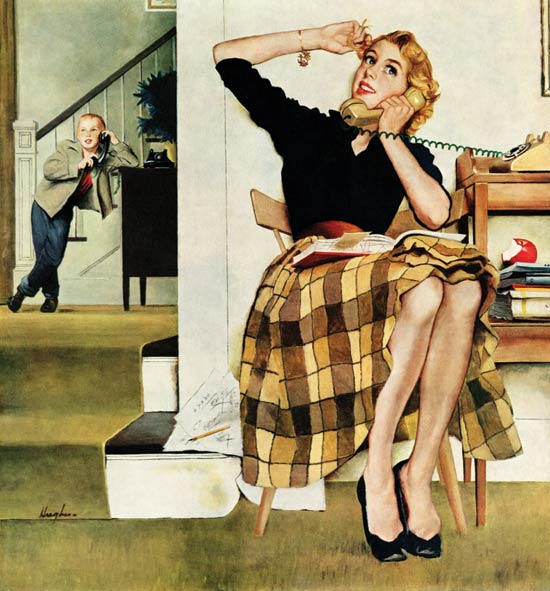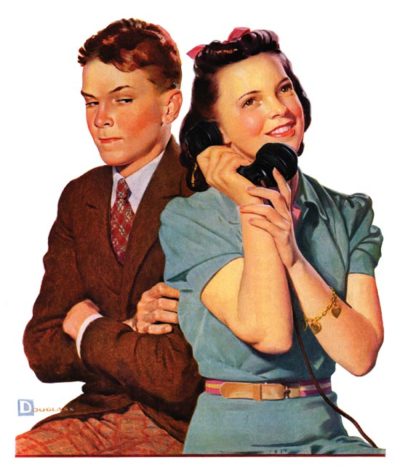Long Live the Landline
Do you still have your old, corded phone? We have 7 Reasons to Keep Your Landline Phone.

The landline was once our connection. For almost a hundred years, it was the model for talking to someone who was not in the room with us. The telephone wire plugged into the wall jack, and the phone wires ran from the house to the perfectly named telephone pole, and from that pole and all of its stalwart cousins standing along our streets, those wires found the people we would talk to on what was called the telephone.
We had a telephone on the little desk in the kitchen. For years the phone would ring, the beautiful sonorous periodic ringing that alerted us all that a call was coming in — someone had dialed our number! — and my mother would answer it. My father, unless he was there alone, did not answer the telephone because it fell under the duties of the household, I think, and he was a welder who was away all day fixing things and didn’t come home to answer the phone. After some years, we had another phone. Not another line, but another phone. When that happened, when people achieved two phones, it was thought far and wide to be a sort of luxury, a phone in the kitchen and one upstairs, so indulgent and in fact sort of lazy in that you wouldn’t have to come down to answer the phone, but you could simply turn there in the bedroom and take the call. It was the beginning of taking a call while not fully dressed.
When the phone rang in our house, we didn’t know who it was. I want to say it could have been anybody, but it couldn’t have been anybody. It was one of four or five people who had our number. We generally knew what they would say by what time the phone rang. Morning calls were certain people, neighbors, and early evening were relatives looking to chat. We didn’t want any calls after 10 or 11 at night, and we lived in fear of any call after midnight. My father said we should unplug it when we went to bed so that no one would have dire trouble in the night.
The telephone didn’t ring a dozen times a day, and its sound was a kind of minor event. Kids didn’t pick up the phone. I didn’t get a phone call until I was 12, if then. My mother would pick up the ringing phone and say hello and we all knew in a moment whom she was talking to, and her voice as she spoke to one of her sisters or my father or a friend was the tenor of the house. We didn’t listen to what she said, but we knew by her tone what the world was like.
There were films and stories in which the people in the dark, lonely house lifted the telephone receiver to find it dead, the wires cut. Sometimes we saw the gloved hand and the wire cutters snip the cord outside in the night. They were cut off! No communication in or out! The people on the island were getting murdered one by one, and there were heavy clues about who would be next, and all of this because the lines were down or cut or out of service. None of this: “Can you hear me now?” It was: “No one can possibly hear us now.” People were alone. Now, of course, the people on the island, as soon as there is any mischief, all send text messages with photos along with voicemails from their cellphones. So, everybody is safer, but our stories have taken a mortal blow from the fact that no one now is ever alone. No one is going to write a film where the bad guy goes around with his tiny little snippers and clips the internal diode in each cellphone. And most of the time, in the world that offered that special condition — being alone — as a possibility, it was a good thing. We miss it.
There is a moment we also miss, which was a wondrous landline moment. The phone would ring after dinner, and my brother would answer it and say hello, and after a moment, he would holler, “Ronnie! It’s for you.” The phrase is long gone because no one shares a phone anymore. And my brother would call me loudly enough to wake the house, the downstairs and the upstairs. I was 16 and the phone was for me! But he wouldn’t stop there. He would ask, as he’d been instructed in phone etiquette, who was calling, and then he would yell, at the same terrific volume, “It’s Joylene!,” a name that had never been said aloud before in my house and the sound of which would arouse in all listeners, mainly my mother and father and little brother, the same alertness as if he had said, “There is an alligator in the house! A big one!” I would spring from my bed, throwing to the floor (sacrilege!) the new issue of Famous Monsters of Filmland I’d been studying, and sprint down the stairs, sweat bursting from my forehead before he could add what I heard him say as I turned the slippery corner into the kitchen: “Ronnie, it’s Joylene, a girl from school!” Then I would yank the phone from him, ignoring his grin, and say hello to Joylene, the nicest girl in the 10th grade, in such a way as to make it sound like, “Yes, who’s calling and why are you bothering me?” And no matter that she needed to know what time I would pick her up for the sophomore dance tomorrow night, I would answer in monosyllables, listening hard to the old telltale clues of our house so I could hear the residents creeping closer in the hall to hear what Ronnie was saying to Joylene: yes, no, okay, yes, sure, okay. Bye. And standing there in the kitchen in a household with a landline, I knew that the news was now public. Ronnie was taking Joylene to the dance. The village had been alerted.
This is the information we’re not getting now. There are no such moments in our beautiful houses now when the phone rings and everyone stops and listens to it ring twice, knowing someone else will rise to answer, and the communal well will fill.
Ron Carlson is the award-winning author of six story collections and six novels, most recently Return to Oakpine. His fiction has appeared in Harper’s, The New Yorker, Playboy, and GQ, and has been featured on NPR’s This American Life and Selected Shorts.

From the Archive: Reach Out and Touch
Though landline phones may be on the endangered species list, in the 1950s and before, they were the lifeline of communities — and a teenager’s life. Throughout the 20th century, telephone accessibility and use increased dramatically. And with more use came more misuse. To counter growing problems with the mumblers, party-line hogs, and profanity, utility companies launched national campaigns to instruct consumers on proper telephone etiquette.
In So Many Words
People who talk interminably about conversation being dead in the United States ought to listen for a change — preferably on a party line. The Federal Communications Commission, in its recently published statistics for the fiscal year of 1954, reports that there were, on an average, 179,000,000 local telephone conversations a day, as well as 6,600,000 long-distance calls daily.
Purists frequently have strict interpretations of what constitutes conversation, but even in the 18th century undoubtedly only a minuscule part of talk was “brilliant.”
Perhaps the most pleasant conversation in the world is the easy, friendly exchange of personal thoughts and doings, which wouldn’t rate one-two with Dr. Samuel Johnson.
At any rate, telephone-company officials estimate that in a three-minute call the number of words exchanged may range — depending on whether the conversation is at a “normal pace” or a “blue-streak” rate — from 450 to 750, averaging about 500 words a call. This means, in a manner of speaking, that the nation’s telephone conversations represent approximately 185,000,000 addresses and soliloquies a day. Anyway it’s a safe bet that among all the trivial and perfunctory telephone messages, an extraordinary number of people at both ends of the telephone line every day find in their own “conversation” something pretty essential to getting through an average day.
—“Is Our Talk Witty, or Just Non-Stop?,”
Editorial, July 16, 1955
You Talking to Me?
In the Bell System and in other large companies, such as the General Telephone Corporation, the problem is classified as one of etiquette, or manners. A look at their bulging files on etiquette suggests that, among all the machines with which men have complicated their living while seeking to enrich their lives, the telephone stands apart. It is used more frequently by more people than any other complex mechanism we have, but the more it is used, the more it is misused. In contrast to the oboe, which Danny Kaye condemned as an ill wind nobody blows good, the telephone has to be described as a good instrument nearly everybody ill-treats.
Bad telephone manners are by no means limited to those who shout, or to those who hold the transmitter more than an inch from their lips when speaking. They are also displayed by the mumblers; the chewers and gnawers who try to talk with a mouth full of gum, or with pipes, cigars, pencils, or other impediments between their teeth; the wrong-number guessers who disdain directories; the executives who want the party they are calling to be on the line before picking up their own phones; the party-line hogs; the busy, busy people who let their phones ring and ring before answering; the operator baiters; and a long list of others. To the telephone executive, they all add up to one thing — wasteful inefficiency. Even the time-honored word “hello” is now passé. It is a fascinating, if idle, speculation to wonder how Alexander Graham Bell, the man who invented the telephone in 1876, would make out if he should return from his grave. It was his habit to open a telephone conversation with a resounding “Whoo-hoo.”…
Since the United States has more telephones in service than all the rest of the world combined, by a ratio of about six to five, it is here that the problems of bad telephone manners reach gigantic proportions. The operating utilities long ago realized that the installation of equipment and the maintenance of service was only part of their job. As early as 1912 they had begun a campaign to teach subscribers how to make more effective use of the instrument.
In that year the New York Telephone Company, a part of the Bell System, asked one of its bright young copy writers — a fellow named Howard G. Stokes — to prepare a booklet that could be used in this educational program. Stokes took the oblique approach. He felt he couldn’t come right out and tell the customers they were a lot of ill-mannered, ill-tempered boors, however truthful that might have been. So he reminded his readers that a display of friendliness is the surest way to get things done easily and quickly, and extolled the virtues of cheerful courtesy. Anticipating Dale Carnegie by decades, Stokes titled his booklet Winning Friends by Telephone, and closed it with the line, “The voice with the smile wins.”
—“How’s Your Telephone Etiquette?”
by Craig Thompson, March 16, 1957
This article is featured in the March/April 2017 issue of The Saturday Evening Post. Subscribe to the magazine for more art, inspiring stories, fiction, humor, and features from our archives.